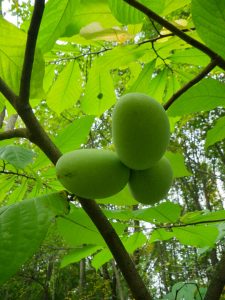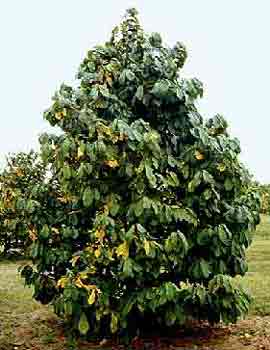Pawpaw
(Asimina triloba [L.] Dunal)
Description
Asimina triloba is a member of the tropical custard-apple family (Annonaceae). It is a small to medium size tree usually growing 15 to 20 feet tall but can grow up to 40 feet9. The common name is derived from that of an indigenous South American name for the unrelated papaya10. The leaves of the pawpaw are large ( up to 12 inches), alternate and oval-shaped. Leaf size decreases down the stem. April blooming in Maryland, pawpaw has beautiful, deep red or purple flowers with three petals on the inside and three sepals on the outside. Flowers are about 1.5 inch across. The putrid-smelling flowers are likely pollinated by flies and beetles10. Pawpaw produces a large, sweet green fruit similar in appearance to a mango and similar in taste to a banana. The fruit is technically a berry and is the largest on any tree in North America9.
Pawpaw tree9.

Pawpaw flower, @ J. Gallagher2.

Ripe pawpaw fruits, @ A. Shaw11.
Distribution
Pawpaws are native to the United States and can be found in warmer environments from the Gulf Coastal plains to the Great Lakes and even in some parts of England¹. Pawpaws prefer weather conditions that are hot in the summer and cold in the winter with high humidity¹. They can grow well in the shade. Pawpaws also prefer well drained, slightly soils¹. Except for Garrett County, pawpaws can be found throughout Maryland13 along riversides, moist woodlands, and even on some farms².

Distribution of pawpaw, Wikimedia Commons12.
Wildlife importance
Asimina triloba is an important part of their ecosystem because their fruit provides food to many wildlife such as birds and mammals7. Zebra Swallowtail butterfly larva eat the leaves. The fruits are eaten by black bears, raccoons opossums, deer, foxes and squirrels².
Economic importance
Pawpaw is a potential crop species, but has not yet been developed. It has potential over a broad climatic range and the fruits have nutritional value. Additionally, the wholesale and nursery market for plants is great14.
Threats
The pawpaw peduncle borer is the only known pest, and it is relatively rare. The larvae of this moth bore into the flowers and prevent successful fruit set8.
Interesting facts
- Pawpaw seeds, barks, and leaves can be used to make home remedies for alternative treatments that can help reduce fever, vomiting, inflammation and vomiting³.
- Every third Thursday September it is national Pawpaw Day where people celebrate the fruit by going to farms or markets to buy and taste5.
- Pawpaw is the state fruit of Ohio11, and there is an annual Pawpaw festival held in Albany, Ohio by the Ohio Pawpaw Growers Association that is held on National Pawpaw Day6.
- An American folk song describes picking the fruit².
Where, oh where is dear little Nellie?
Way down yonder in the pawpaw patch
Pickin’ up pawpaws, puttin’ ’em in your pocket
References
- Blossum Nursery: Pawpaw habitat and climate
- Maryland Grows–Pawpaws: the tropical fruit from our forests
- RxList: American pawpaw
- University of Georgia Extension. Minor Fruits and Nuts in Georgia
- National Day Calendar: National Pawpaw Day
- Ohio Pawpaw Festival
- USDA, Forest Serviced Fire Effects Information System: Asimina triloba
- Purdue University Cooperative Extension Service, Growing Pawpaws
- University of Kentucky, College of Agriculture, Food and Environment: Pawpaw
- Peterson Pawpaws: Pollination
- Metro Parks, Westervile, Ohio: Pondering pawpaws.
- Wikimedia Commons, Asimina triloba range map
- Maryland Plant Atlas: Asimina triloba
- Purdue University, Horticulture: Pawpaw
Contributed by J. C. Youn
Towson University Glen Arboretum

